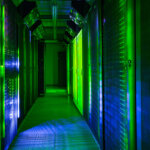Data centers and the path to community partnership

In Part 1 of this article, we spoke to Tom Lawler, Executive Director of the Digital Climate Alliance, about the competing demands of a world running ever more on cloud services and data centers, incoming technologies that will only drive the need for more data centers and processing power, and the ecological concerns of at least a generation about the incredibly energy-intensive and resource-intensive way that data centers function.
In Part 2, Tom talked about innovative ways to green new and modern data centers and where the levers are that help get these changes for a more ecological data center future made actually are. Right now, the drivers are largely financial, but those drivers can be useful to get action from companies once it becomes clear to them that more ecological policies can save them more money.
While we had Tom in the chair, we wondered about the potential of turning data centers from what they have been – power-guzzling, water-thirsty behemoths, driving the cloud, and AI, and machine learning operations we need – into things that communities would welcome in their own backyard.
The look of the future.
THQ:
Are the next generation of data centers going to be essentially just like the data centers we have now, but more efficient?
TL:
I don’t think they can be. I think the next generation of data centers are going to be completely divorced from what we’ve known as data centers in the past. There are opportunities for some interesting new ways to look at data centers and make them more planet-safe and welcome in communities.
Data centers with pass-through water, rather than consumed water, improve the efficiency of the center, for one thing. But one of the great examples is a data center built in the middle of a relatively economically disadvantaged community in Stockton, California. Stockton is often where you think of in terms of the gangster rappers of the 1980s.
By putting a data center in that community, almost immediately of course, what you get is much better connectivity than deprived areas often have.
Suddenly, there was high speed internet, all the way into the city center, that can be utilized by a whole lot of other people. Connectivity is directly linked to better educational results these days, faster medical information, you name it.
In a sense, my vision of the data center of the future is “data center as economic development zone.” Right now, we have lots of people who are in electricity-poverty, but we also have people in connectivity and internet-poverty. That’s a big challenge in terms of economic upward mobility, so we can start utilizing greener data centers as channels of societal improvement.
The companies that want to run data centers have a lot of money them as we have these entities that have a lot of money and they’re willing to pay whatever it takes to get their data centers built – so where we put them needs to be thought about more. It needs to stop being a case of putting them as far out of sight as possible, and start being a case of where they can do the most societal good.
Location, location, location.
THQ:
How do we make data centers more useful to communities in general by virtue of their location?
TL:
I don’t think there’s been enough thinking about that point. The push right now is towards making every data center a hyperscaler, and there are benefits to having more hyperscalers, to be sure. But I don’t think that’s necessarily the ideal people claim it is. Yes, there are efficiencies and economies of scale, but there are reasons for data centers to be in various other places, too, because we can use them to feed back benefits of their operation to the community if and when we start making them on the principle of being greener.
THQ:
No-one wants something in there area necessarily where it’s a drain on their local power and water, but when it can bring connectivity, and potentially those other social uplift elements without being a huge drain on resources, we change the nature of the proposition entirely?
TL:
Yes. And there’s another thing. When it was first launched, if you asked Siri what the weather was in your location, it would go to the cloud, find out the answer, and bring that data back to you. Nowadays, with edge computing, a lot more of the active computing happens locally. Edge computing is not being utilized anywhere near what it could be, and in my mind, it’s the next big thing. With edge computing, you can have small substation-style data centers, the likes of which Intel and Dell are working on in terms of smart substations for the electric grid. That means you get smaller, more local applications and benefits.
THQ:
So we could be looking at a kind of grid-style pattern of data centers in the future? Big hyperscalers for greater energy efficiency per application overall but smaller, more localized data centers bringing connectivity, social uplift and additional benefits to smaller communities, along with the potential of employment benefits, all while hopefully drawing electrons from a range of cleaner greener sources?
TL:
Something like that, yes. There are so many questions that get asked about what data centers can bring the communities local to them, and things like high-speed internet feel like where the centers can start to give back. In addition to which, people are really starting to look for interesting applications for the residual heat created by data centers. For instance, there’s a case in the UK where they’re using the residual heat from a local data center to heat municipal swimming pools. And in Germany, they’ve started using that residual data center heat as part of solution to heating apartment complexes and things of that sort.
So there are plenty of people out there with the creativity and engineering skill to be able to find uses for data center residuals. It’s just that there ae currently not enough cases where the centers are suitable, so not enough people are thinking about them that way yet.
Making the future a reality.
THQ:
So how do we go from where we are to a place where they’re thinking about it more.
TL:
Ironically, the answer is that we need more data.
While we were researching for our white paper, we looked into this and found there are lots of people out there with ideas, but not really any good baseline information on what we’re doing now. If we can get that data, then we could start developing performance metrics, best practices, and really start giving people a roadmap of sustainability, where there’s a clear opportunity for a race to the top.
But right now, everybody’s working with anecdotal evidence and saying “We made this efficiency improvement.” But did we or not? Even just trying to make a comparison of the energy efficiency of a server today with one from ten years ago, it’s almost impossible, because they’re completely different machines doing completely different things.
Step one, we need some data, so we devise some proper measuring sticks to define what progress really looks like against specific metrics.
Then we show progress being delivered. And that’s the plan. Data, metrics, progress, comparability. That’s how we’ll actually know we’re moving in the right direction.
THQ:
OK – so how do we get that reliable data on which this green future of certainty depends? Who needs to start the data-gathering process?
TL:
This is where we think there’s an important role for government. Before we start saying mandate this or mandate that, this is a great place for the government to start collecting information, and providing good standards and ways to standardize that data.
As it stands, anytime anybody puts out data, there’s always somebody who’s going to question or say “I have different data.” With better standardized data, it allows us to move forward And then the federal government can start talking about what it wants in terms of benchmarks.
That I think is the right pathway going forward.










